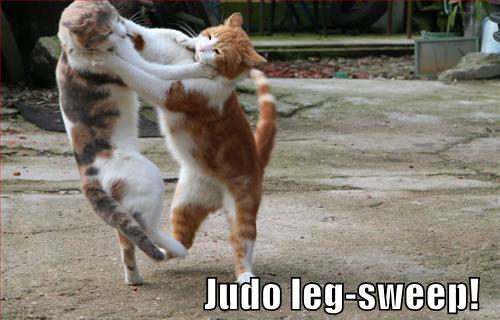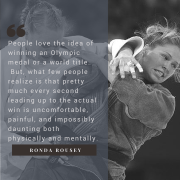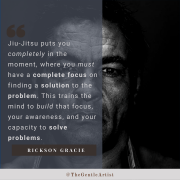
Someone asked me, “is there a difference between BJJ Takedowns & Judo Throws?”
In theory, no not really. But, in practice and actual application there can definitely be some differences in the judo throws & bjj takedowns. The reason for these differences mainly come about due to the way these two martial arts are expressed in sport. The sport of BJJ has many rules to keep its competitors safe. In addition, the rules of sport JUDO also has its own set of rules for safety concerns. In order to be a successful competitor, you must know these rules and operate within them soundly during your attempts to throw a competitor.
So, many BJJ fighters will not use certain judo throws that you would see in JUDO because it may put them at risk for “giving up the back.” Other BJJ fighters will make adjustments to judo throw techniques in order to make it work for their specific game. Sometimes, these adjustments are frowned upon by JUDO traditionalists because they feel that it’s a sacrifice of judo throw technical soundness.
One example of this is Rodolfo Viera’s adaptation of the morote seoi nage otoshi judo throw (skip to the 2:09 minute mark):
As you watch that a couple of times, let the marvel of monstrocity that is Rodolfo Veira wear off. Okay, now take note of how he finishes his version of the morote seoi nage otoshi judo throw. First off, he immediately drops to his knees to finish the throw. Secondly, he drops off to his side rather than directly in front of the person being taken down. And, he judo throws the person at an angle. He does this, because performing the morote seoi nage otoshi judo throw with strict traditional form would put him at risk for giving up his back. Giving up his back to another monster like Andre Galvao would mean he could potentially start the match with a deficit of 4 points, or, worse, Galvao would submit him.
This is the way a traditional highly technical JUDO champion teaches a compilation of the morote seoi nage judo throw in competition:
So, what do you think? What’s your opinion? Which art has the better takedowns? Does it make sense to compare?
Either way, if you want to be a better grappler you should be supplementing your jiu-jitsu with some judo training. If your academy doesn’t offer judo, and joining a judo club isn’t viable you could supplement your training with personal study.
Claudio Calasans suggests learning Judo for Jiu-Jitsu due to the following:
- Learning Judo opens up a bigger world of grappling to you.
- If you compete, it gives you more options than to just pull / let pull.
- All fights start on your feet.
- Judo gives you a good base from which to learn to pass guard.
Follow me: @rubeneavila



Judo players use Vieira’s version all the time, it’s called seoi otoshi (shoulder drop). I think it’s a false dichotomy to compare a throw done in competition (Vieira) versus a throw done as demonstration (Inoue), because obviously competition-throws either in BJJ and judo are contingent on numerous circumstances whereas demo throws have nice compliant partners.
I see what you are saying, but there is a slight technical difference. In seoi otoshi the grips are different. From my understanding the seoi otoshi calls for sleeve grip and shoulder grip. However, the way Rodolfo does the throw it’s a morote grip. However, he does drop to his knees and to the side like the seoi otoshi. Perhaps we should call it morote seoi otoshi lol. =P
I agree, it isn’t very fair to compare a throw with an uke versus a live fighter. It’s very hard not to point to something that shows “the way it should be done” so to speak though.
The grips have nothing to do with whether a throw is classified as Seoi Otoshi. Otoshi refers to the dropping action and that uke is pulled down rather than loaded onto the shoulder and lifted before throwing. The same-sided grip Rodolfo uses is common in Judo, as is the method of throwing. Morote is an old way of describing Seoi-Nage with one hand on the lapel and one on the sleeve – now it is just referred to as Seoi-Nage. The method of throwing capturing your opponents arm with your elbow is called Ippon-Seoi Nage. Again, everything Rodolfo is doing in regards to this throw is very common in Judo competition and not invented or adapted for BJJ.
I hear you, but there doesn’t seem to be so many conflicting opinions on the matter of what to call this. I have just about given up.
I haven’t seen this in JUDO competition. Not this specific way. But, I’ll take your word for it. Thanks for contributing.
BJJ is a form of Judo and pretty much all the BJJ takedowns exist in Judo. A BJJ player trained in Judo will usually be a better grappler than the one who isn’t
Simon, I completely agree. My teammates and I were talking about this yesterday over dinner after the american cup. Jiu-jitsu players who are trained in Judo are much more complete grapplers. Marcelo Garcia and Andre Galvao, to name a few, are two perfect examples of this.
It would good idea one third video of what happens when the morote seoi nage goes wrong, ie, with the dangers of give back.
That is a great idea! I’ll see what I can find, Ares. Thanks for contributing.
What about the wrestlers and the takedowns we do?
Hey Antonio, thanks for commenting. What do you mean exactly? Are you asking my opinion of wrestling takedowns? If so, I think they are just as important as Judo takedowns.
BBJ is just a part of Judo. Ne-waza (ground) techniques from Judo form the basis and focus of BBJ. Being said that, a 3Y BBJ student has better ne-waza techniques that it’s 3Y Judo counterpart, but in the other hand, Judo student has a broader knowledge (throws,etc).
Once you get a certain expertise on Judo, BBJ gives you no added value.
The father of BBJ, master Helio Gracie, was beaten by the judoka master Masahiko Kimura. With all my respect to master Gracie, broader Judo techinques showed to be more effective, he kissed the floor several times by Kimura’s throws and was also beaten by Kimura superior ne-waza techniques.
Ivan, thanks for coming by and posting your two cents. I have to respectfully disagree. I think learning Judo in combination with BJJ makes you a more complete martial artist. I don’t see one art is completely superior to the other in any respects other than what they were intended for. A judoka will always win the battle standing up, and a bjj player will always win on the ground. But, it’s unnecessary for us to think this way. We should strive to learn all grappling arts: bjj, judo, greco-roman wrestling, sambo, etc. The UFC is a great tool to look at what happens when you are one dimensional.
Pleased to post my to cents. Well, I have to admit that modern competition Judo ne-waza has taken some techniques from BBJ or even Sambo.
UFC? 😀 … UFC guys don’t wear Judogi.
I though we were comparing and discussing about martial art techniques, specifically Judo vs BBJ. In the case of UFC’s fights, there are other base techniques more suitable than BBJ or Judo (Muai Thai, Kick boxing, boxing, “just kick his face”-jutsu…), and honestly, grappling technique doesn’t require to be much sophisticated there.
The point I was trying to make is that we, as martial artists, would be better off being competent in all facets of grappling and if we become one dimensional we run the risk of becoming obsolete and not reaching closer to our potential. The elite european jodokas all train jiu-jitsu and that is why they fare better in newaza than most of their western counterparts. The same argument can be made for bjj. The best of the best in bjj all have a very strong judo background as well. There’s no denying the effectiveness of either martial art. The answer is in combining what is most useful to you from each.
Hi Ruben, I just wanted to point out your great responses to the subject. I’m glad you keep an open mind regarding cross-training, maybe 50 years go there was no much difference between Judo and BJJ (actually BJJ was just Kosen Judo, which focus mainly on the ground). But now a days new rules are changing the game in competitions BJJ and Judo now look like two different martial arts. Same as I see BJJ players complete disregard for standup, I also see Judo players complete disregard for ground game mostly guard game. Just to add to a complete martial artist, I personally think that if you are a Grappler, whatever the you specialty is, you should be familiar with BJJ, Judo, Sambo, Wrestling to name a few. But if you are a martial artist you should add Striking even once a week to at least be aware of effective techniques in competition vs real situations
I appreciate your kind words, Sebastian. I completely agree, the sports of judo and Brazilian Jiu-Jitsu are driving these two arts further away from each other with all the rules they add each year. I definitely am starting to see myself as more of a grappler than just a BJJ player. I am slowly adding more and more wrestling and judo to my repertoire. However, you make a fantastic point that we need to incorporate striking to really consider ourselves martial artists. Thanks for your comment!
A Judoka standing almost always win one of BJJ.
But one of BJJ not always beat a Judoka in Newaza.
There are countless examples of this.
Judo is usually 50% tachiwaza 40-60% newaza.
BJJ is usually 95% newaza 5% tachiwaza.
Seems a tad biased, no?
Because of competition and rules, Judo and BJJ have focused on different aspects of grappling. Tournament Judo gives competitors mere seconds to execute a pin or ground submission before the referee will return them to standing position. The vast majority of scoring is done with throws Thus there is less payoff to focus on the ground game and ne waza is given less emphasis in practice.
In contrast BJJ sees the vast majority of scoring on the ground, with no time limits for ground grappling unless both competitors remain passive. Victory is most often achieved via submission with locks and chokes emphasized. The throw alone is rarely if ever decisive so it is given less focus in practice. Thus in theory the arts of Judo and BJJ are much the same, in practice you will tend to see a much better ground game with BJJ and much better throws with Judo. That is simply what the scoring system and tournament rules reward and incentivize.
To me Judo and BJJ, with similar lineage but different emphasis are the two halves of a complete grappling art. At the higher levels they tend to converge or a least overlap to a greater extent. To see how amazing the combined mastery can be, look at Aoki Shinya, who is a dominant force in his weight class in an MMA environment where he faces strikers of all kinds. Advocates of both Judo and BJJ can be proud of the amazing take downs and submissions from the Grand Master of the Flying Submission.
I completely agree. Judo is beautiful and the best grapplers in the world can throw, sweep, submit with and without the gi. I embrace all grappling styles.
Well deep traditions cross paths if one studies History . BJJ is a descendant of Japanese Kano Jiu Jitsu (AKA Judo) Brought to Brazil after Mitsuyo Maeda a student of Kano’s left the United States Military Academy in 1905 after being pinned by a 300 lb Offensive Lineman. Maeda arrived in Brazil I believe in 1907 or so. He was given a job by the Gracie’s and a place to live.
In return he taught the Kano Jiu Jitsu to Carlos, Gastao, and Helio Gracie.
Kano Jiu Jitsu was taken from the 5 Schools of Kito Ryu Kempo (Quan Fa) as taught by Chen Gempai a master of Chinese Chin Na and emissary from China to Nagasaki. Kano removed the most dangerous techniques and called his School the Kodokan Judo.
Now I know a little about this as I was a friend of one of the Original Kano Students. He told me that what happened in is Japan then focused on throws and balance and moved away from locks and holds, while the Brazilian Tradition focused more on those techniques.
This became the main difference in the art forms. “But you must realize they are still the same.”
My friend passed away some years back but he is a recognized name among all Judo ka in the United States. He was also the training partner of Donn F Draegar the “Blue Eyed Samurai and Masahiko the Legend Kimura.
In closing I will only repeat what my friend said to me, “They are all the same.” One body different appendages.
Oss! “Keep living the Gentle Way”
Whoa, thanks for sharing that Randal! I appreciate the education. I totally agree that it’s all the same. I think all forms of grappling are beautiful. Thanks again buddy.
To quote Jun Fan- “Don’t get all caught up in the traditional, take what is useful and discard what is ineffective.” Jiu Jitsu regardless the brand is simple, yet effeeffective. But always remember Jiu means gentle, jitsu means art. This is why Rohnda Rousey lost. She tried to use force, unyielding power. This is neither the way of Judo, nor Jiu Jitsu. She played Holly Holt’s game and lost. Keep Living the gentle way, Oss.